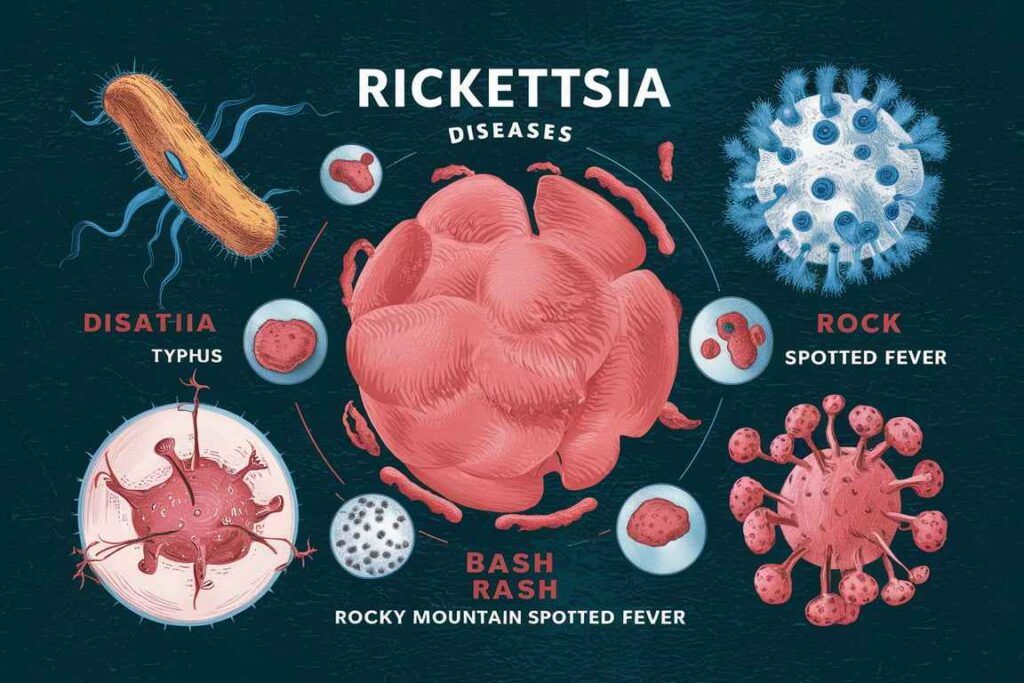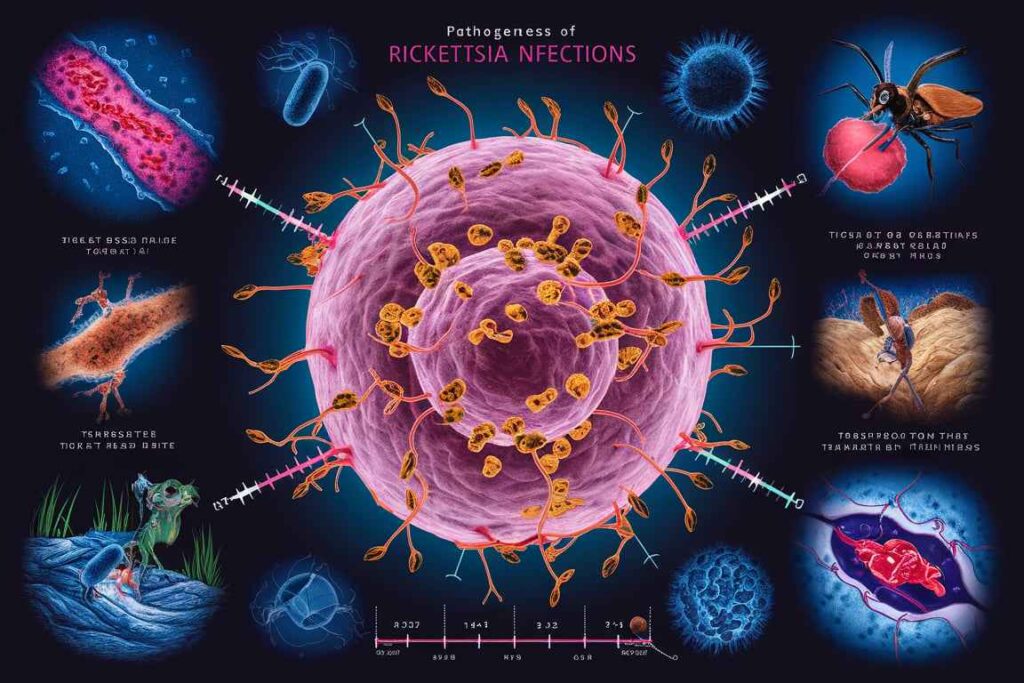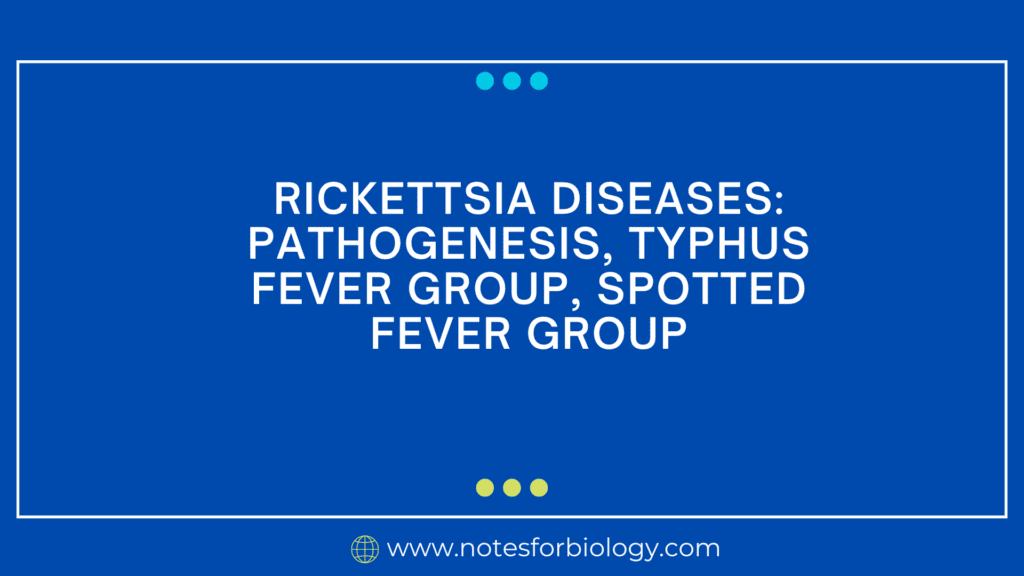Rickettsia is a genus of obligate intracellular bacteria that cause a variety of diseases in humans. Rickettsia diseases infections are usually spread by arthropod vectors such ticks, fleas, and lice. Here’s a detailed look at the etiology of the two main Rickettsia disease groups: Typhus fever and Spotted fever.
Table of Contents
Rickettsia diseases
Rickettsia diseases are infections caused by bacteria from the genus Rickettsia. Rickettsia diseases are obligatory intracellular pathogens that infect the endothelial cells that line the blood arteries. Rickettsia diseases are usually transmitted to people via the bites of infected arthropods such ticks, fleas, and lice. Symptoms include fever, headache, and rash, and if not treated swiftly, they can progress to serious consequences. The main Rickettsia disease groups include Typhus fever and Spotted fever.

Pathogenesis

Pathogenesis of Rickettsia infections:
- Rickettsial bacteria enter the human body via a bite from an infected arthropod vector.
- Attachment and Invasion: The bacteria adhere to and invade the endothelial cells that line the blood arteries.
- Intracellular Survival: Rickettsiae escape the phagosome and reproduce in the cytoplasm of host cells.
- Cell harm: They directly harm endothelium cells and activate the host’s immunological response, resulting in increased vascular permeability.
- Dissemination: The bacteria propagated via the circulation and infected several organs.
Immune response:
- The host’s immunological response includes the activation of macrophages and the generation of cytokines.
- T cells and antibodies play critical roles in infection control.
- The infection can trigger a systemic inflammatory response, resulting in symptoms like fever, rash, and multi-organ involvement.
Typhus Fever Group
The Typhus fever group includes diseases caused by Rickettsia prowazekii and Rickettsia typhi.
Epidemic Typhus
- Transmission: Human bodily louse (Pediculus humanus corporis).
- Reservoir: Humans.
- Symptoms include high temperature, severe headache, a rash that begins on the trunk and spreads to the extremities, muscle discomfort, disorientation, and hypotension.
- Complications: Severe cases can include delirium, stupor, and death. Brill-Zinsser illness is a recurring variant of epidemic typhus that can develop years after the first infection.
- Serologic techniques (Weil-Felix test, immunofluorescence assay) and PCR were used to make the diagnosis.
- Antibiotics (doxycycline, chloramphenicol).
Murine Typhus
- Rickettsia typhi is the causative agent of murine Typhus.
- Rats transmit fleas (mainly Xenopsylla cheopis).
- Reservoir: rodents (particularly rats).
- Symptoms include fever, headache, rash (often beginning on the trunk), muscle soreness, nausea, and vomiting.
- Serologic and PCR assays were used to make the diagnosis.

Spotted Fever Group
The Spotted fever category encompasses diseases caused by numerous Rickettsia species, the most well-known of which is Rocky Mountain spotted fever.
Rocky Mountain Spotted Fever (RMSF)
- Caused by Rickettsia rickettsii.
- Ticks are responsible for transmission.
- Reservoir: Small animals and ticks.
- Symptoms include a high fever, severe headache, rash (which starts on the wrists and ankles and spreads to the trunk, palms, and soles), nausea, vomiting, abdominal pain, and muscle pain.
- Complications: If left untreated, severe cases can cause vasculitis, organ damage (kidneys, heart, lungs), and even death.
- Diagnosis: Clinical presentation, serologic testing, PCR, and immunohistochemistry staining of biopsy tissues.
- Treatment: Antibiotics (doxycycline); early intervention is crucial.
Mediterranean Spotted Fever
- It is caused by Rickettsia conorii bacteria.
- Ticks (Rhipicephalus sanguineus) transmit the disease.
- The reservoir consists of dogs and ticks.
- Symptoms include fever, headache, rash (sometimes with eschar at the tick bite site), and muscle soreness.
- Serologic and PCR assays were used to make the diagnosis.
- Treatment with antibiotics (doxycycline).
General Points for Diagnosis and Treatment
Diagnosis:
- Clinical Symptoms: Key signs include fever, rash, headache, and a history of possible vector contact.
Lab tests:
- Serologic tests (Weil-Felix test, immunofluorescence assay) are used to identify antibodies.
- PCR for detecting rickettsial DNA.
- Culture is rarely performed because of the high level of biosafety required.
- Immunohistochemically staining of biopsy specimens.
Treatment:
- Antibiotics: Doxycycline is the preferred treatment for the majority of rickettsial infections. Chloramphenicol is an option, especially when doxycycline is contraindicated.
- Supportive Care: The treatment of symptoms and problems as needed.
Frequently Asked Question
Define Rickettsia diseases.
Rickettsia diseases are infections caused by bacteria from the genus Rickettsia. These bacteria are obligatory intracellular pathogens that infect the endothelial cells that line the blood arteries. Rickettsia diseases are usually transmitted to people via the bites of infected arthropods such ticks, fleas, and lice. Symptoms include fever, headache, and rash, and if not treated swiftly, they can progress to serious consequences.
What is pathogenesis of rickettsia infection?
The pathogenesis of Rickettsia infection are:
1. Rickettsial bacteria enter the human body via a bite from an infected arthropod vector.
2. Attachment and Invasion: The bacteria adhere to and invade the endothelial cells that line the blood arteries.
3. Intracellular Survival: Rickettsiae escape the phagosome and reproduce in the cytoplasm of host cells.
4. Cell harm: They directly harm endothelium cells and activate the host’s immunological response, resulting in increased vascular permeability.
5. Dissemination: The bacteria propagated via the circulation and infected several organs.
Related Article
External and middle ear infection: otitis externa and otitis media




